
LOADING ...
In response to evolving domestic opinion, eMedals Inc has made the conscious decision to remove the presentation of German Third Reich historical artifacts from our online catalogue. For three decades, eMedals Inc has made an effort to preserve history in all its forms. As historians and researchers, we have managed sensitive articles and materials with the greatest of care and respect for their past and present social context. We acknowledge the growing sentiments put forth by the Canadian public and have taken proactive actions to address this opinion.


Lt.cmdr Fovargue - Malta Campaign Mine Casualty
Lt.cmdr Fovargue - Malta Campaign Mine Casualty
SKU: ITEM: GB1013
Current Bid:
Your Max Bid:
Bid History:
Time Remaining:
Couldn't load pickup availability
Shipping Details
Shipping Details
eMedals offers rapid domestic and international shipping. Orders received prior to 12:00pm (EST) will be shipped on the same business day.* Orders placed on Canadian Federal holidays will be dispatched the subsequent business day. Courier tracking numbers are provided for all shipments. All items purchased from eMedals can be returned for a full monetary refund or merchandise credit, providing the criteria presented in our Terms & Conditions are met. *Please note that the addition of a COA may impact dispatch time.
Shipping Details
eMedals offers rapid domestic and international shipping. Orders received prior to 12:00pm (EST) will be shipped on the same business day.* Orders placed on Canadian Federal holidays will be dispatched the subsequent business day. Courier tracking numbers are provided for all shipments. All items purchased from eMedals can be returned for a full monetary refund or merchandise credit, providing the criteria presented in our Terms & Conditions are met. *Please note that the addition of a COA may impact dispatch time.
Description
Description
Description


You May Also Like
Russia, Imperial. An Order of St. Vladimir, IV Class in Gold, Military Division, c.1905
EU24277
Yugoslavia, Kingdom. An Order Of St. Sava, Knight Commander Cross, By Huguenin, c.1935
EU24276
Serbia, Kingdom. An Order Of Saint Sava, Breast Star
EU24275
Serbia, Kingdom. An Austrian-Made Order of St. Sava, Type II, Grand Cross c.1905
EU24274
Russia, Imperial. An Order of St. Vladimir, IV Class in Gold, Civil Division, c.1830
EU24273
-
Russia, Imperial. An Order of St. Vladimir, IV Class in Gold, Military Division, c.1905
EU24277
Add to CartRegular price $3,450 USDRegular price $0 USD Sale price $3,450 USDUnit price / per -
Yugoslavia, Kingdom. An Order Of St. Sava, Knight Commander Cross, By Huguenin, c.1935
EU24276
Add to CartRegular price $425 USDRegular price $0 USD Sale price $425 USDUnit price / per -
Serbia, Kingdom. An Order Of Saint Sava, Breast Star
EU24275
Add to CartRegular price $850 USDRegular price $0 USD Sale price $850 USDUnit price / per -
Serbia, Kingdom. An Austrian-Made Order of St. Sava, Type II, Grand Cross c.1905
EU24274
Add to CartRegular price $850 USDRegular price $0 USD Sale price $850 USDUnit price / per -
Russia, Imperial. An Order of St. Vladimir, IV Class in Gold, Civil Division, c.1830
EU24273
Add to CartRegular price $2,850 USDRegular price $0 USD Sale price $2,850 USDUnit price / per
Do you have a similar item you are interested in selling?
Please complete the form and our client care representatives will contact you.
Sell Item








